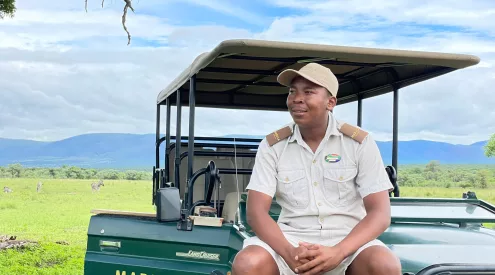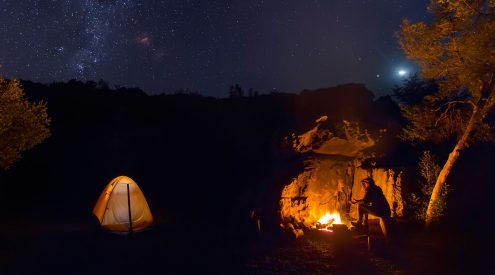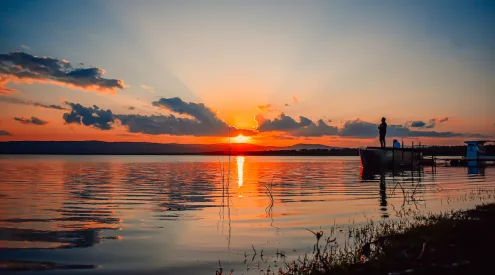These uncrowded, affordable national parks and nature reserves in South Africa are some of the country’s best-kept secrets and are worthy of a weekend visit.

Where to find some of the best secret parks and nature reserves in South Africa.
Secret parks and nature reserves in South Africa
Find a great safari package to suit your budget here
1. Bontebok National Park, Western Cape
Nearest town: Swellendam
10 caramel-coloured wooden chalets line the Breede River banks, beneath the towering Langeberg Mountains that form the backdrop to one of the smallest nature reserves in South Africa and its smallest national park. It was originally set up in 1931 to protect the world’s 30 remaining bontebok, a population which now flourishes in the coastal fynbos and renosterveld. Spend your days wallowing or paddling in the river, driving to numerous lookout points where grey rhebok, red hartebeest and the park’s namesake roam, or walking one of the leisurely nature paths ranging from the 1,6-kilometre Acacia Trail to the 5,4-kilometre Bushbuck Trail. Then end the day on the wrap-around chalet deck, watching the sun slip away with a crackling fire and the calls of the African fish-eagle as a backing track.
The semi-private chalets are fully equipped for self-catering and each has two single beds and a double sleeper couch (chalet number seven has the best river views). The campsite works on a first come, first served basis and is split into two areas – one behind the chalets with more than enough braai facilities, a central ablution block and electricity points, and the other on the river’s edge. While the views are better from the latter sites, you have to walk a short distance to the amenities and there are no electricity points.
GPS co-ordinates for Bontebok National Park
Cost to stay in Bontebok National Park
Chalets from R186 an adult and R93 a child a night (base rate: R840). Camping from R62 an adult and R31 a child a night (base rate: R170). Daily conservation fees from R30 an adult.
Contact details for Bontebok National Park
SANParks central reservations, Tel 012 428 9111, email [email protected], www.sanparks.org
2. Blouberg Nature Reserve, Limpopo
Nearest town: Vivo
A dream destination for twitchers and nature lovers, Blouberg Nature Reserve is home to 1330 breeding pairs of endangered Cape vultures as well as lappet-faced, hooded, whiteheaded, white-backed, the rare Ruppell’s vultures and more than 225 other recorded bird species. Catch all the action from the Vulture Restaurant hide, which is best visited during winter months – and don’t forget your binoculars and camera (a good telephoto lens is recommended for excellent shots). While it’s well worth a visit for that alone, it’s also one the nature reserves in South Africa with bushveld savannah spotted with baobab trees and is also home to giraffe, zebra, Cape buffalo, sable antelope and kudu, which often wander through the four self-catering camps. Wildlife is best viewed on the four-night Blouberg Wilderness Trail.
The four thatched four-sleeper cottages at Mashatu Camp are fully equipped, but don’t offer the same ‘bush’ feeling as the other three camps. The unfenced Tamboti Bush Camp has four rustic safari tents with solar-powered lighting, a fully kitted-out kitchen and a large braai area next to a huge tamboti tree. It can only be booked by a single party, so it’s completely private.
Then there’s Molope Bush Camp in the heart of a beautiful forest of mature weeping boer-bean and nyala trees. It has five private campsites complete with showers and flushing toilets, but no electricity.
Lastly, if you’re looking for a self-sufficient, back-to-the-bush experience with very basic facilities (i.e. bucket shower, pit toilet and a small braai place), pitch your tent at Modumele Wilderness Camp. What it lacks in facilities it more than makes up for in atmosphere.
GPS co-ordinates for Blouberg Nature Reserve
Cost to stay in Blouberg Nature Reserve
Entrance is R20 an adult and R30 a vehicle. From R600 a night for two at Mashatu and for four at Tamboti. Molope is from R150 and Modumele from R200 a night for two people. Minimum two nights over weekends.
Contact details for accommodation at Blouberg Nature Reserve
Cell 078 869 5240, 015 293 3611, email [email protected], www.kunemoya.co.za
Contact details for Blouberg Nature Reserve
Cell 071 113 4940, 083 601 5530, or 083 251 7071, email [email protected], www.friendsofblouberg.org.za
3. Lekgalameetse Nature Reserve, Limpopo
Nearest town: Tzaneen
With seven quaint, wooden cabins alongside the nameless river at the base of the towering Wolkberg Mountain, Lekgalameetse is the epitome of a forest getaway. Although in the same general area, each self-catering unit occupies its own secluded spot in the dense indigenous forest, so the samango monkeys jumping from branch to branch are more likely to bother you than your neighbours.
The nicest thing about staying here is that you’re never far from the sound of water, with cabin four claiming the best river views. A long walk upstream will take you past clusters of inviting natural swimming pools with sparkling, clear water and rabbles of butterflies, particularly in late summer. Or you can head out in a 4×4 past the waterfall, following tracks that lead to wonderful stops on top of the mountain, such as the lookout point from The Downs, and The Cathedral picnic spot in a shaded grove of trees. The area was also the backdrop to the lives of interesting characters during the Anglo-Boer War, and history buffs can arrange a guided tour to see the sights and hear tales of the British soldiers who settled here after the war.
GPS co-ordinates for Lekgalameetse Nature Reserve
Cost to stay in Lekgalameetse Nature Reserve
From R480 a chalet a night, plus a one-off entrance fee of R15 a person and R25 a vehicle.
Contact details for Lekgalameetse Nature Reserve
Limpopo Tourism Agency, Tel 015 293 3600, email [email protected], www.golimpopo.com
4. Fort Fordyce Nature Reserve, Eastern Cape
Nearest town: Fort Beaufort
When it comes to nature reserves in South Africa, this might be the find of the century. To get there, you’ll pass through an amphitheatre of mountains, disappear into thick forest and wind up a gravel road that eventually emerges on top of the Amathole escarpment. From here, the endless views of the crumpled landscape, taking in the Hogsback and Katberg mountains, are arguably the best in the Eastern Cape. Burchell’s zebra, black wildebeest, mountain reedbuck and red hartebeest wander the plateau, often passing just in front of your doorstep. The reserve is best explored on foot along a number of trails, but its drawcard is the exceptional crags that attract Spiderman-footed rock climbers. There’s a shaded picnic spot next to the dam near reception that is perfect for lunch, but beware of the sneaky Chacma baboons, whose barks echo across the forest canopy.
There are three accommodation options inside the reserve. Maqoma’s Den (close to the reception area) sleeps four and Pakamisa comfortably sleeps six; both are basic, concrete buildings with everything you need, including an indoor fireplace for chilly winter nights. If you can, book the quintessential forest log cabin known as Harris Hut. You’ll need a 4×4 to get there and after parking it’s still a short walk to the hut, but that’s a small price to pay for a home surrounded by indigenous yellowwoods and milkwoods, the scene completed by a gently flowing stream.
GPS co-ordinates for Fort Fordyce Nature Reserve
Cost to stay in Fort Fordyce Nature Reserve
From R450 a night (max. four people).
Contact details for Fort Fordyce Nature Reserve
Eastern Cape Parks and Tourism Agency, Tel 043 701 9600, email [email protected], www.ectourism.co.za
5. Thakazulu Game Reserve, KwaZulu-Natal
Nearest town: Ulundi
If you’ve ever wondered why elephants love a good spa treatment, here’s your chance to find out. At the base of the valley created by the Black Mfolozi and Thaka rivers lies a natural mud bath, supposedly one of only five in the world. After overcoming the strange, snot-like texture of the mud, its 30-odd minerals will leave your skin feeling as if you’ve had a beauty treatment, without the cost.
If you’re up for something more adventurous, try the 65-metre zipline, go abseiling or tackle one of the challenging 4×4 routes that include river crossings, cambers and occasional sightings of zebra, giraffe, kudu, impala and nyala. Once you’ve passed the crocodiles’ resting pen, head to the reserve’s on-site accommodation at Thangami Safari Spa, take a dip in the naturally heated mineral pools, grab a bite from the restaurant and see how many of the 250 identified bird species you can spot from the deck.
The basic, semi-detached self-catering units and camping areas are set on two terraces – the upper one concealed in monkey-infiltrated trees and those lower down with better views across the valley. For the best views and relative privacy, the reasonably priced honeymoon suite takes the cake.
GPS co-ordinates for Thakazulu Game Reserve
Cost to stay in Thakazulu Game Reserve
Camping is from R100 an adult a night and chalets from R160 a person sharing on a midweek night. Honeymoon suite from R500 a night.
Contact details for Thakazulu Game Reserve
Thangami Safari Spa, Tel 083 256 6036 (be patient with intermittent reception), www.thangami.co.za
6. D’Nyala Nature Reserve, Limpopo
Nearest town: Lephalale
D’Nyala demands a slow, relaxed pace where days revolve around food, game-viewing and unwinding with a good book. This relatively small, tranquil reserve gets its name from the majestic nyala tree that grows up to 30 metres high and is identified by its gnarled and crooked trunk (look for the huge nyala tree – you can’t miss it as you drive into the camp).
The park is also famous for being the southernmost habitat of the baobab tree and there are a number of these dotted throughout the 8 000 hectare reserve.
Self-drive along the well-sign-posted route that takes you through an impressive landscape of mopane, marula, knobthorn, wild fig and leadwood trees. The loop takes about two-and-a-half hours to complete, but could take much longer if you get caught up at the reserve’s main attractions: two game-viewing hides – Tamboti in the north and Kokoriba in the south – overlooking the flat Tambotie River savannah plains. Given the locations, you’d be unlucky not to spot white rhino, giraffe, waterbuck, zebra, tsessebe and eland, especially during the drier winter months.
The resort-style camp is frequented by monkeys and kudu, but is possibly more famous for being the venue of peace talks between Nobel Peace Prize winner FW de Klerk and Cyril Ramaphosa, in the early 90s. They no doubt enjoyed the comfortable facilities as much as the modern visitor will: wooden four-sleeper chalets, double-bed VIP suites, a conference centre (check to see if this is booked by a large group) and an enormous pool, which is great for kids.
GPS co-ordinates for D’Nyala Nature Reserve
Cost to stay in D’Nyala Nature Reserve
VIP suites from R650 and chalets from R450 a night, plus a one-off entrance fee of R15 an adult and R25 a vehicle.
Contact details for D’Nyala Nature Reserve
Limpopo Tourism Agency, Tel 015 293 3600, email reservation@ golimpopo.com, www.golimpopo.com
7. Plumari Game Reserve, North West Province
Nearest town: Rustenburg
Plumari Game Reserve in the Magaliesberg is the perfect place for a pampered wilderness weekend getaway. The luxurious four-star Askari Lodge inside the reserve takes you back in time with one of the largest private collections of ox wagons in South Africa and decor pieces dating back to the 1800s.
The fine-dining Karibu Restaurant and opulent, thatched chalets with wooden patios and en-suite Victorian bathrooms overlook Elephant Dam, where many antelope and bird species gather to share sundowners. For the hardened bush-goer, the reserve may seem a little like a glorified zoo, but the two-and-a-half-hour game drive to see the resident lions, white rhino, buffalo, hippo and wildebeest, and the ‘touch and feed’ experience with two habituated teenage elephants are not to be missed, especially for kids. Complete your stay here by treating yourself to a massage or beauty treatment at the on-site spa.
GPS o-ordinates for Plumari Game Reserve
Cost to stay in Plumari Game Reserve
DB&B from R1 260 a person sharing. Games drives cost R295 and the elephant interaction is R490.
Contact details for Plumari Game Reserve
Askari Game Lodge and Spa, Tel 014 577 2658, email [email protected], www.askarilodge.co.za
8. Songimvelo Nature Reserve, Mpumalanga
Nearest town: Barberton
Bordering Swaziland’s northwest and woven into a diverse tapestry of rolling hillsides, hidden valleys, forested ravines and open plains, Songimvelo is one of Mpumalanga’s bestkept secrets. The Komati River winds across the valley floor on its quest to the sea and is the primary water source for the reserve’s animals. An easily navigable self-drive through the reserve offers sightings of Burchell’s zebra, blue wildebeest, red hartebeest, waterbuck and blesbok that wander the grassy plains and giraffe, impala and kudu that thrive in the denser woodland. Elephant and, unfortunately, hornless white rhino are also frequently seen.
The reserve covers such a large area that its accommodation, Kromdraai Camp, is 20 kilometres east of the main gate. There is a camping area, but as the rates are so affordable, it’s worth booking into one of the rustic, self-catering six-sleeper wooden cabins. They’re fully equipped, reasonably spaced apart from one another and maintain that special feeling of being in the bush. Apart from a short walk to the Komati River, there are no activities in the camp, so pack some toys and games. A new upmarket lodge overlooking the river within the fenced game reserve area is currently being developed and is expected to open this summer.
GPS co-ordinates for Songimvelo Nature Reserve
S26.0426°, 031.00360° (Kromdraai Camp)
Cost to stay in Songimvelo Nature Reserve
From R450 a chalet a night, plus a one-off entry fee of R15 a person and R25 a vehicle. Self-driving in the reserve is R125 a vehicle and guided game drives are R125 a person.
Contact details for Songimvelo Nature Reserve
Mpumalanga Tourism and Parks Agency, Tel 013 759 5300, email [email protected], www.mtpa.co.za
9. Wolwespruit Nature Reserve, Gauteng
Nearest town: Bothaville
Scenic, quiet and isolated, Wolwespruit is one of those perfect nature reserves in South Africa for those wishing to get away from the crowd and enjoy a weekend’s peace and tranquillity. Most keen anglers are quick to head to Bloemhof Dam Nature Reserve to throw a line into the Vaal River, but there’s also yellowfish aplenty just 130 kilometres upstream at Wolwespruit – and a totally different setting. The pretty riverine bush provides a welcoming habitat to many bird species, which are particularly abundant in summer. Most notable are shrike, starling, thrush, pink-billed larks, swallow-tailed bee-eaters and giant kingfishers. Hiking is the best way to view the variety of antelope found on the grassy plains including kudu, blesbok, zebra and hartebeest.
There are rustic campsites all along the riverbank, which have no flush toilets or electricity but do have the more important things in life: a braai area and great views of the river. The positioning of campsites 18 and 19 – close to the ablutions and with more convenient river access than others – makes them the most sought after.
GPS co-ordinates for Wolwespruit Nature Reserve
Cost to stay in Wolwespruit Nature Reserve
Camping from R50 a site a night (max. six). Stone House Cottage is from R250 a night. Entrance is R30 an adult and angling costs R20 a person a day.
Contact details for Wolwespruit Nature Reserve
Wolwespruit Nature Reserve, Tel 018 581 9705, email [email protected], www.parksnorthwest.co.za
10. Molopo Game Reserve, North West Province
Nearest town: Vryburg
Much like its more famous nearby neighbour, Kgalagadi Transfrontier Park, Molopo Game Reserve is characterised by gently sloping red Kalahari dunes studded with bushman grass that is ideal grazing for herds of plains game such as eland and wildebeest, and an abundance of typical Kalahari birdlife.
The need for a 4×4 as well as Molopo’s remoteness and winter hunting season, combined with a lack of large predators and luxury facilities, make it one of the lesser-known nature reserves in South Africa. It’s therefore emptier – perfect for those seeking solitude.
Both day and night drives are possible, but the best way to experience the reserve’s stillness is to park off at one of the six artificial waterholes and let the animals come to you. Before you head out, ask concessionaire Gerald Botha to point you to where the largest concentrations of game have recently congregated.
The campsites at Phiri Camp are spread over a wide area, but most are close to the ablution blocks. With this relative privacy, you really get the feeling of camping out alone under incredible night skies in the African bush, but remember temperatures in this region are extreme. Winter days are hot, yet nights are near freezing; in summer it’s boiling hot most of the time.
The nearest town with decent supplies, Vryburg, is 240 kilometres away, so you’ll need to come fully prepared with enough fuel, food and water and a vehicle capable of tackling sections of rough corrugations and sand.
GPS co-ordinates for Molopo Game Reserve
Cost to stay in Molopo Game Reserve
Camping is from R65 a person a night, plus a one-off entrance fee of R25 a person.
Contact details for Molopo Game Reserve
Gerald Botha, Cell 082 873 8780. For more information, visit North West Parks, www.parksnorthwest.co.za



























